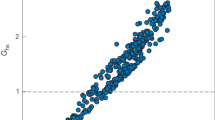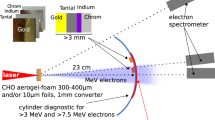Abstract
The goal of the laser fusion program is the production of energy from nuclear fusion reactions induced by focusing powerful laser beams on very small targets that contain a mixture of deuterium and tritium (DT) fuel. If the laser beams can sufficiently compress and heat the target in a short enough time, the fuel will undergo nuclear fusion to produce more energy than was put into the system. Target design is an important part of this laser fusion program. Target geometries ranging from bare, hollow, glass, or metal microspheres to a multilayered or even multishell design are currently of interest [1,2]. One feature common to the various target designs is the fuel core, the hollow sphere containing the DT fusing fuel. This core is typically a 100-μm-diameter glass microballoon (GMB) having a wall thickness of about 1 μm. The GMB is filled with up to 10 ng of DT, which corresponds to a room-temperature pressure of up to 10 MPa (100 atm).
Access this chapter
Tax calculation will be finalised at checkout
Purchases are for personal use only
Preview
Unable to display preview. Download preview PDF.
Similar content being viewed by others
References
R. J. Mason and R. L. Morse, Phys. Fluids 18: 814 (1975).
R. J. Mason and R. L. Morse, Nucl. Fusion 15: 935 (1975).
R. J. Mason, Nucl Fusion 15: 1031 (1975).
T. M. Henderson, R. B. Jacobs, D. E. Solomon, and G. H. Wuttke, in: Advances in Cryogenic Engineering, Vol. 21, Plenum Press, New York (1975), p. 455.
F. Skoberne, “Laser Program at LASL, January 1–June 30, 1975,” Los Alamos Scientific Laboratory Rept. LA-6050-PR (1976), p. 80.
F. Skoberne, “Laser Program at LASL, July 1–December 1, 1975,” Los Alamos Scientific Laboratory Rept. LA-6245-PR (1976), p. 82.
E. R. Grilly, Rev. Sci. Inst. 48: 148 (1977).
L. J. Campbell, private communication (January 1974).
C. K. Briggs, R. G. Hickman, R. T. Tsugawa, and P. C. Souers, “Estimated Values of Some Cryogenic Properties of Hydrogen Isotopes,” Lawrence Livermore Laboratory Rept. UCRL- 76708 (1975).
R. P. Reedy, “The Selection and Measurement of Microsphere Laser Targets,” Lawrence Livermore Laboratory Rept. UCRL-76903 (1975).
B. S. Newberger and W. S. Hall, “Computer Generated Interferograms to Characterize Micro- balloons” (to be published).
Author information
Authors and Affiliations
Editor information
Editors and Affiliations
Rights and permissions
Copyright information
© 1978 Plenum Press · New York and London
About this chapter
Cite this chapter
Miller, J.R. (1978). A New Method for Producing Cryogenic Laser Fusion Targets. In: Timmerhaus, K.D. (eds) Advances in Cryogenic Engineering. Advances in Cryogenic Engineering, vol 23. Springer, Boston, MA. https://doi.org/10.1007/978-1-4613-4039-3_83
Download citation
DOI: https://doi.org/10.1007/978-1-4613-4039-3_83
Publisher Name: Springer, Boston, MA
Print ISBN: 978-1-4613-4041-6
Online ISBN: 978-1-4613-4039-3
eBook Packages: Springer Book Archive




